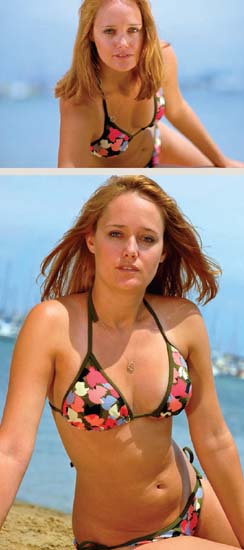
There comes a point in every artist’s life when his vision exceeds the natural light that surrounds him. He starts thinking about the light he’s been playing with, the mood he’s been creating. He realizes that he’s just been hunting. Sure, he’s making things happen, but the key elements are out of his control. The light he truly needs is missing. What he requires is a tool that can help him add light to a very specific area—one that doesn’t splash it around everywhere. He needs a reflector.
A reflector is anything that reflects light. Your shirt can be a reflector—so can the side of a building, a table top, or even a piece of paper or cardboard. Of course, a basic 42-inch store-bought reflector is a popular choice too. Spend one beautiful Saturday in your city’s public park and you’ll probably spot a photographer or two shooting portraits with them.
Reflectors are intended to reflect light into the shadow areas of your subject. Photographers use them primarily for outdoor portraiture though they are sometimes used in the studio as well.

Besides simply making something brighter, a reflector allows you to build your own dynamic message. You do not have to settle, hunt, or hope. You simply add light where it is needed. If you want something brighter, then angle the reflector and add light. Of course, you’ll need someone to hold the reflector and be at the perfect angle for that reflection to occur. Granted, it’s not the easiest tool to use (and sometimes not the most flattering), but it is a tool nonetheless, and it can add a lot of light.

Before buying a reflector, explore all your options. Think about how you’ll be using it. If you don’t have an assistant, then a reflector that sits on the ground may be the option for you.
A reflector can also enlarge a smaller light source (such as a flash) quite efficiently. Artists can easily incorporate them into their message-building process.
Store-bought reflectors are fairly inexpensive. Prices range from $30 to $100 for some of the “professional” models. There are many sizes and various colors available, and most of these tools are reversible. Some reflectors even come with zippered slipcovers offering other colors or reflective material. They tend to come with their own carrying case and fold to about a third of the disc’s open size.
Spend some quality time with your reflector and learn how to use it. It’s something you have to experience first hand. Join a club or photo group that shoots portraits, and undoubtedly, at some point, a reflector will be brought in. Be sure to spend plenty of time wrangling the light yourself. You need to understand how difficult it can be to hold the disc. This will give you the insight needed when teaching others how to hold it for you.